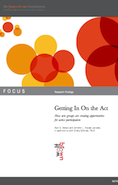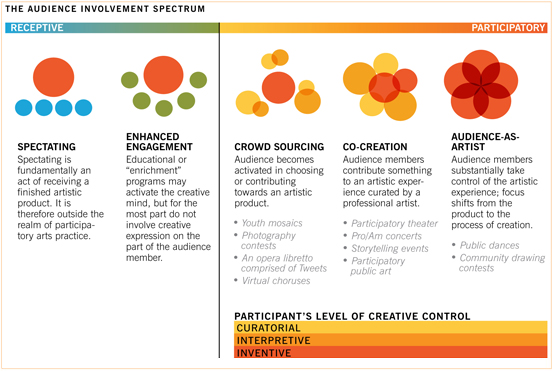 Getting In On the Act
Getting In On the Act Arts participation is being redefined as people increasingly choose to engage with art in new, more active and expressive ways." />
 Getting In On the Act
Getting In On the Act
Arts participation is being redefined as people increasingly choose to engage with art in new, more active and expressive ways. 
Getting In On the Act
Arts participation is being redefined as people increasingly choose to engage with art in new, more active and expressive ways.
This compelling trend carries profound implications, and fresh opportunities, for a nonprofit arts sector exploring how to adapt to demographic and technological changes.
Getting In On the Act: How Arts Groups are Creating Opportunities for Active Participation is a new study commissioned by The James Irvine Foundation and conducted by WolfBrown. It draws insights from more than 100 nonprofit arts groups and other experts in the U.S., U.K. and Australia. The report presents a new model for understanding levels of arts engagement as well as case studies of participatory arts in practice. It also addresses many of the concerns that arts organizations may have in supporting participatory arts practices and provides inspiration and ideas for exploring this growing trend.
Understanding Audience Involvement
With growing frequency, artists and arts organizations are integrating active arts practices into their work, often through collaborations and partnerships. The Audience Involvement Spectrum is a simple framework developed to describe the different ways participatory arts programs work, and the various entry points for participation. This five-stage model illustrates a progression of involvement from “spectating” — in which the audience member plays only a minor role in shaping the artistic experience — to the point at which there is no conventional “audience” at all because every person involved is creating, doing or making art.

Within the three participatory stages of the Audience Involvement Spectrum, audiences are involved at various levels of interactivity or creative control: curatorial engagement (selecting, editing, organizing, voting), interpretive engagement (performing, remaking an existing work of art), or inventive engagement (creating something entirely new). These levels add further dimension to the spectrum, and may be helpful in providing language to describe a complicated area of arts practice.
The full report is available for download from the James Irvine Foundation’s website.
